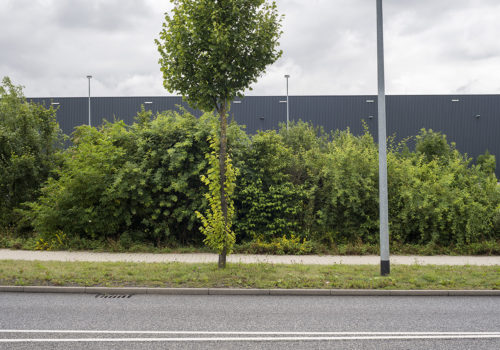The exhibition by Cécile Cuny, Nathalie Mohadjer and Hortense Soichet takes up its summer quarters at Espace Hamilton from June 11 to July 24, 2021, to close the postponement of the fourth edition of Fictions Documentaries, a festival of social photography. This investigative work with those who work on the gigantic European logistics platforms takes us to meet people of flesh and blood, within this universe of desolate wasteland and imperturbable cogs. A high point of meeting between artists and the public, in the presence of Michel Poivert, historian of photography, is organized on the weekend of June 11, 12 and 13, 2021 at Espace Hamilton.
Logistics consists of organizing the storage and transport of raw materials, industrial components and goods from their places of manufacture to their places of consumption. The image of “just in time” and the promises of its digitization present this activity as a continuous and self-regulated flow of goods. However, warehouses are essential points of passage to be able to control, store, separate, prepare and reship goods to their final destination. These activities are carried out by sorting agents, forklift operators, shipping agents, receiving agents, material handlers, storekeepers or pickers. These trades represent 13% of blue collar jobs in France, 17% in Germany. They are mainly located in logistics areas on the outskirts of large cities.
Often criticized for their environmental pollution, logistics zones are the work of concrete operators. From the 1970s to the 1990s, logistics locations mainly took place within pre-existing industrial zones. The land, acquired and rehabilitated by public development companies, was available for any type of business establishment. The role of municipal authorities was limited to signing building permits. During the 1990s, a real estate market emerged dominated by large international firms (Prologis, Global Logistic Properties, Goodman, Segro). These firms develop and manage logistics areas of several warehouses, completely private and closed, for which they are solely responsible: from the construction of the buildings to the fitting-out, including day-to-day management.
It is precisely on these new places for workmen and on the social worlds that is developing from them that the investigation presented in this exhibition focuses.
Meetings and guided tours in the presence of the artists are organized on June 11, 12 and 13 at Espace Hamilton (Carcassonne). Michel Poivert, photography historian and teacher at the Sorbonne, will be alongside the photographers to discuss their work during critical meetings. Also on the program, a film screening in partnership with the International Political Film Festival
The photographic work presented in this exhibition was produced with the collaboration of researchers Clément Barbier, David Gaborieau, Gwendal Simon and Nicolas Raimbault.
This exhibition is co-produced by the Maison de la photographie Robert Doisneau, the urban planning laboratory of the University of Paris-Est Marne-la-Vallée and the GRAPh-CMi of Carcassonne
GRAPh-CMi : Cecile Cuny, Nathalie Mohadjer, Hortense Soichet : On n’est pas des robots
June 11 – July 24, 2021
Espace Hamilton
30 rue Armagnac
11000 Carcassonne
















